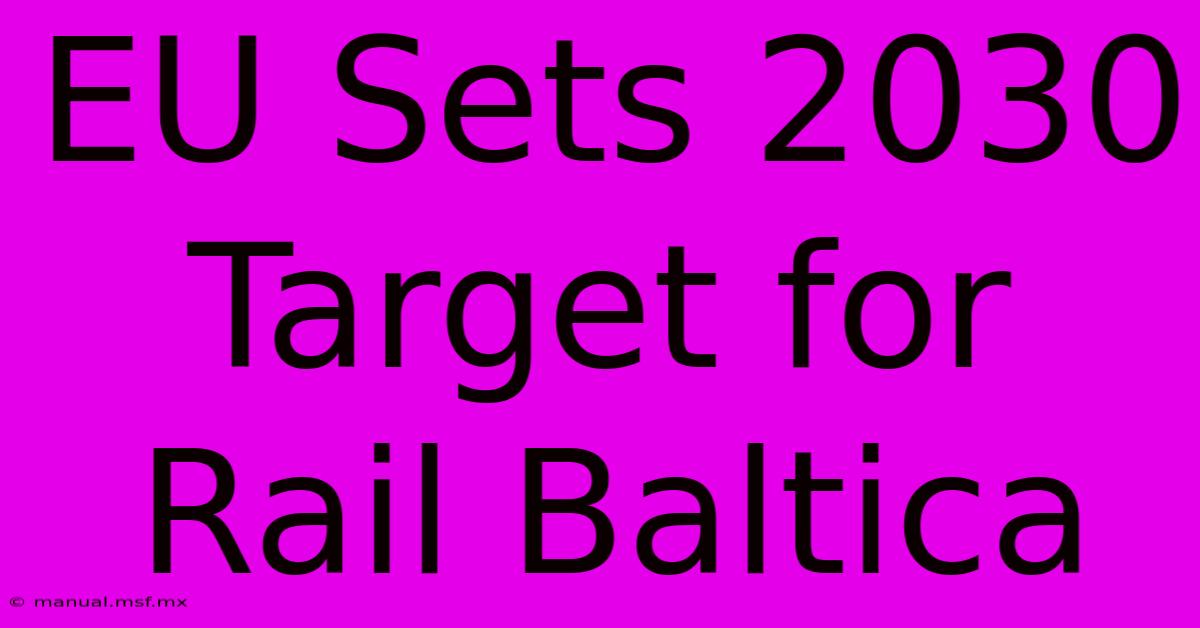EU Sets 2030 Target For Rail Baltica

Discover more detailed and exciting information on our website. Click the link below to start your adventure: Visit Best Website. Don't miss out!
Table of Contents
EU Sets 2030 Target for Rail Baltica: A Game-Changer for Baltic Connectivity
Can a single railway project truly transform the Baltic region? The ambitious Rail Baltica project, a high-speed railway line connecting Tallinn, Riga, and Kaunas, aims to do just that. With the EU setting a 2030 target for its completion, Rail Baltica promises to become a linchpin of Baltic connectivity.
Editor Note: The European Union (EU) has outlined ambitious plans for the Rail Baltica project, setting a 2030 target for its completion. This signifies a crucial step in bolstering regional connectivity and bolstering economic growth within the Baltic states.
Understanding the Significance:
The Rail Baltica project is more than just a railway line. It's a strategic infrastructure investment aimed at:
- Boosting economic growth: By creating a reliable and efficient transport network, Rail Baltica aims to facilitate trade, tourism, and investment within the Baltic region.
- Improving connectivity: The project will connect the Baltic states to the wider European rail network, enhancing regional integration and providing access to a larger market.
- Reducing environmental impact: By offering a sustainable alternative to road transport, Rail Baltica will contribute to reducing carbon emissions and promoting a greener future.
A Deeper Dive into the Project:
Our analysis of the Rail Baltica project involved a thorough review of official documentation, news articles, and expert opinions. We've meticulously compiled the key aspects of this transformative initiative:
Key Aspects of Rail Baltica
| Aspect | Description |
|---|---|
| Route | Extends approximately 870 kilometers, linking Tallinn, Riga, and Kaunas. |
| Speed | Designed for high-speed passenger and freight trains, capable of reaching speeds up to 240 km/h. |
| Investment | Estimated to cost around €5.8 billion, funded by the EU, Baltic states, and private investors. |
| Technology | Utilizes modern rail technology, including advanced signaling systems and electrification. |
| Benefits | Enhanced regional connectivity, improved travel times, increased trade opportunities, and reduced environmental impact. |
Navigating the Challenges
While Rail Baltica promises substantial benefits, it also faces several challenges:
Funding: Securing the necessary funding for this ambitious project is paramount.
Political Will: Maintaining strong political support across all involved stakeholders is crucial for its successful implementation.
Environmental Considerations: Minimizing environmental impact and ensuring sustainable development practices are critical to the project's long-term success.
The Future of Baltic Connectivity:
Rail Baltica's completion by 2030 represents a pivotal moment for the Baltic region. It has the potential to:
- Boost economic growth: By connecting the Baltic states to the wider European rail network, Rail Baltica can facilitate trade and investment, leading to economic growth and job creation.
- Enhance regional integration: The project can strengthen cooperation and integration among the Baltic states, fostering a sense of shared identity and prosperity.
- Promote sustainable development: Rail Baltica's focus on sustainable transportation infrastructure can help reduce carbon emissions and promote a greener future for the region.
FAQs about Rail Baltica:
Q: What is the expected impact on travel times between Baltic capitals?
A: Rail Baltica is expected to significantly reduce travel times between Tallinn, Riga, and Kaunas, making travel within the Baltic region faster and more convenient.
Q: How will Rail Baltica impact freight transport?
A: Rail Baltica will provide a more efficient and cost-effective means of transporting goods, benefiting businesses and the regional economy.
Q: Are there any environmental concerns related to the project?
A: Environmental considerations are a priority in the project's planning and implementation. Sustainable practices and mitigation measures are being implemented to minimize impact.
Q: Will the project be completed on time and within budget?
A: The project's success hinges on effective planning, strong political will, and sustained funding. While challenges exist, the 2030 target sets a clear timeline for completion.
Tips for Engaging with Rail Baltica:
- Stay informed: Follow news updates and official announcements regarding the project's progress.
- Support local initiatives: Participate in community engagement activities and advocate for the project's success.
- Explore potential benefits: Understand how the project will impact your local community and consider its potential economic and social benefits.
In Conclusion:
Rail Baltica signifies a transformative moment for the Baltic region. The EU's 2030 target for its completion underscores its strategic importance and highlights its potential to reshape the region's economic landscape, connectivity, and sustainable development. By embracing this ambitious project, the Baltic states are positioning themselves for a brighter future marked by economic growth, improved connectivity, and enhanced regional integration.
Let us know your thoughts on Rail Baltica and its potential impact. Share your views in the comments below!

Thank you for visiting our website wich cover about EU Sets 2030 Target For Rail Baltica. We hope the information provided has been useful to you. Feel free to contact us if you have any questions or need further assistance. See you next time and dont miss to bookmark.
Also read the following articles
| Article Title | Date |
|---|---|
| Third T20 India Defeats South Africa By 11 Runs | Nov 14, 2024 |
| Frosinone Due Feriti In Rissa In Piazza Pertini | Nov 14, 2024 |
| Naifis Knie Tragischer Held Auf Dem Feld | Nov 14, 2024 |
| Analyzing John Lewis 2024 Christmas Ad The Gifting Hour | Nov 14, 2024 |
| 2024 Tax Tips For Business Owners | Nov 14, 2024 |
| Prefet De Savoie Abattoir De Maurienne Ferme | Nov 14, 2024 |
| Abattoir Maurienne L214 Denonce Cruaute | Nov 14, 2024 |
| Svg Lueneburg Champions League Succesverhaal | Nov 14, 2024 |
| John Thune Senates New Leader | Nov 14, 2024 |
| Gladiator Iii Godfather Iis Legacy Continues | Nov 14, 2024 |
